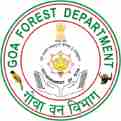FOREST TYPES OF GOA
The forests of Goa are typical of the Western Ghats (Southern Maharashtra and Karnataka). There is diversity in the forests due to the variation in altitude, aspect, soil characters, slope etc. As per Champion and Seth (1968) Classification of Forest types of India, the forests of Goa fall in the following types:-
(i) Estuarine vegetation consisting of mangrove species along narrow muddy banks of rivers [4 B/TS1 and 4B/TS2]
(ii) Strand vegetation along the coastal belts
(iii) Plateau vegetation confined especially to the low altitude
a. Open scrub jungle (5.E7)
b. Moist mixed deciduous forests [3B/C2]
c. Secondary moist mixed deciduous forests [3B/C2/2SI)
d. Sub-tropical Hill forests [8A/C2]
(iv) Semi-evergreen and evergreen forest.
a. Semi-evergreen forests [2A/C2]
b. Lateritic Semi-evergreen forests [2 E4]
c. Evergreen forests [1A/C4]
(i) Estuarine vegetation of mangroves along swampy river banks [4 B/TS1 and 4B/TS2]:-
This type occurs in isolated small patches along the banks of Mandovi and Zuari rivers and other salt water streams. Botanically this zone is characterized by peculiar root formations (stilt roots of Rhizophora, pneumatophores in Avicennia, knee root in Bruguiera etc). The mangroves are found in the division mainly at Durbhat, Panaji, Agassaim and Cortalim. The above categories of vegetation occur from sea level to 100m.
(ii) Strand and creek vegetation along the coastal belt: -
Most of the coastal regions of Goa is rocky with projecting ridges. The strand vegetation is limited to a few patches of narrow strip bordering the Arabian Sea. The vegetation along the south bank of the river Mandovi near Panaji belongs to this category. Tree species mainly found are Pongamia pinnata, Thespesia populinea, Calophyllum inophyllum, Cerbera manghas and Pandanus tectorius. Many herbaceous species such as Neanotis rheedei, lphigenia indica, Begonia crenata, Habenaria grandifloriformis, Tricholepis glaberrima, Trichidesma sp. are found along rocky creeks and projecting ridges facing the coast.
(iii) Plateau vegetation along undulating terrain and hills:
A major portion of the vegetation in Goa belongs to this category, which is further divided into four types viz. (a) Open Scrub jungle, (b) Moist deciduous forests, (c)Secondary moist mixed deciduous forests and (d)Sub-tropical hill forest.
(a) Open scrub jungle (5.E7):This type of vegetation occurs from Panaji to Cortalim and from Bicholim to Sanquelim. Anacardium occidentale is found on an extensive scale. The vegetation is mainly composed of dry deciduous elements such as Carissa congesta, Hollarrhena pubescens, Lantana camara, Calycopteris floribunda, Woodfordia fruticosa, Grewia abutilifolia, Vitex negundo and species of Calotropis, Ziziphus, Cassia, Ixora, Acacia, Albizia, Terminalia and Crotalaria.
(b) Moist mixed deciduous forests [3B/C2]: This is the main forest type, found in Goa, covering more than half of the forest areas. In North Goa Division, this type occurs around Tudal. Ordofind, Butpal, Molem, Codal, Abiche Gol near Valpoi, and Anmod ghat. Predominant species are Terminalia crenulata, T. belerica, T. paniculata, Lagerstroemia parviflora, Adina cordifolia, Albizia lebbeck, A. procera, Mitragyna parvifolia, Holoptelia integrifolia, Trewia nudiflora, Dillenia pentagyna, Semicarpus anacardium, Mallotus philippensis and Stereospermum colais.
(c) Secondary moist mixed deciduous forests [3B/C2/2SI):Trees found in this type are knotty and of coppice origin. A few trees of primary origin are found scattered. Such type is found mainly in areas of "Kumeri cultivation" and in other areas affected by biotic interferences. The main species found are Terminalia crenulata, T. chebula, Adina cordifolia, Alstonia scholaris, Lannea coromandelica, Bombax ceiba, Careya arborea and Dillenia pentagyna.
(d) Sub-tropical Hill forests [8A/C2]:These forests have formed due to "Kumeri cultivation" in the past. Syzygium cuminii and Cinnamomum verum are of common occurrence. Caryota urens is the most common palm in this type of forest. In the second storey, Strobilanthes callosus, Elaeagnus conferta and Capparis sp. are found.
(iv) Semi-evergreen and Evergreen forests:
(a) Semi-evergreen forests [2A/C2]:This type occurs intermingling between tropical evergreen and moist deciduous forest mostly above 500 m.s.l. and is found at Ambochegol, Molem, Butpal and Nadquem. Species composition is of Artocarpus hirsutus, A. gomezianus, Calophyllum sp., Sterculia guttata, Kydia calycina, Lagerstroemia microcarpa, Pterospermum diversifolium, Garcinia indica, Diospyros montana and Macranga peltata.
(b) Lateritic Semi-evergreen forests [2 E4]:This type of Forests is found on shallow dry lateritic soils. Xylia xylocarpa is the prominent tree species with other associates like Pterocarpus marsupium, Grewia tiliifolia, Terminalia paniculata, Schleichera oleosa, Careya arborea ,Bridelia retusa and Strychnos nuxvomica.
(c) Evergreen forests [1A/C4]: This type occurs in deep gorges and depressions and also along the nallahs and streams in the Ponda-Amboli-Rambhat belt. The main species are Calophyllum calaba, Garcinia gummigutta, Canarium strictum, Lophopetalum wightianum, Myristica sp.,Knemaat tenuata, Chroisophyllum acuminata, Palaquium ellipticum, Artocarpus gomezians, Diospyrus ebenum, Mangifera indica, Persea macrantha, Mimusops elengi, Hopea ponga, Olea dioica, Hydnocarpus pentendra, Syzygium cumini, Holigarna arnotiana, Litsea coriacea, Mallotus philippensis, Ficus sp.etc. Osmunda regilis, the royal fern, which is rare in the peninsular India, is also found in this type of forest.





